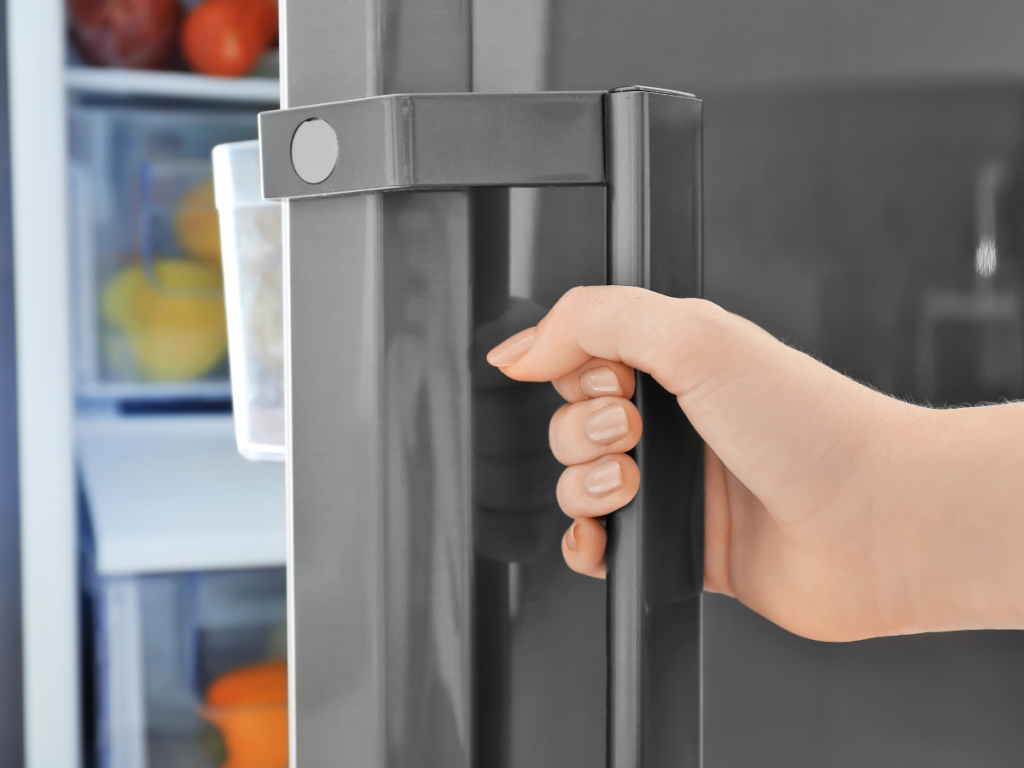Looking to get solar panels installed? Before doing so it’s worth looking at your appliances. Take stock of how many appliances you have, and what their power needs are. That way, you can be sure to get enough solar power in your home to keep everything running. Refrigerators, in particular, consume a lot of energy.So, if you’re wondering, “How much solar power do I need to run a refrigerator?” Atlasta Solar is here to help! Read on to find out everything you need to know, beginning with how much energy typical fridges actually use.

How Much Energy Does A Refrigerator Use?
To calculate how much solar power for a fridge, you need to know how much energy your refrigerator uses in the first place. Refrigerator power consumption is greatly determined by refrigerator size and other factors. All appliances require a specific amount of energy to run. A general rule of thumb is the larger the appliance, the more energy is required. The year and make of the refrigerator need to be considered (older appliances are usually less energy efficient). So, how do you find out the energy requirements for your fridge?
Check for Labels
New fridges in the US have EnergyGuide labels that provide an estimate of the fridge’s annual energy consumption in kilowatt-hours, or kWh. Since the 1980s, most appliance manufacturers provide this bright yellow label on their appliances. In addition to clearly stating how much energy the fridge needs to run, the EnergyGuide label also lists an estimated cost of running the fridge for a year.
Did you peel the label away or have an older fridge that didn’t come with one? Check the instruction manual to find Energy Guide information, visit the manufacturer’s website, or give the manufacturer a call. It’s also possible there may be a different label on the back of the refrigerator that states power requirements.
Once you have this basic EnergyGuide consumption value determined, it’s easy to calculate how much solar power you need. Simply speak with a professional solar panel installation company (such as Atlasta Solar) and their staff can walk you through your actual solar needs.
Find the Quoted Power Rating
Depending on your fridge, you may also find another way to determine your refrigerator power needs. Inside the fridge where the serial number is listed should also be the fridge’s energy requirement in watts. If the required volts and amps are listed, multiply these two to get the number of watts.
If you are unable to find the exact watts your fridge needs, know that EnergyStar refrigerators generally use 350kWh annually, while older models usually consume 600kWh annually.
Calculate Running Watts
Once you know the annual kWh your refrigerator needs, let’s calculate how many running watts, or how much solar energy needs to be generated. Take your fridge’s annual kWh and divide this by 365 to find the daily kWh requirement. To find the hourly kWh amount, divide the daily kWh amount by 24. Let’s use a 350 kWh fridge as an example:
350 kWh divided by 365 (days in a year) = .95 kWh per day
.95 kWh per day divided by 24 (hours in a day) = .04 kWh per hour
.04 x 1000 kWh = 40 watts an hour
So, to power this 350 kWh fridge, you will need a solar system that can generate equal to or greater than 40 watts an hour. Need help calculating watts? At Atlasta Solar we know exactly how to calculate all that, for all appliances.

How To Determine How Many Solar Panels Are Needed
Now that we know how much solar power is needed to power a refrigerator, let’s determine how many solar panels are needed. Solar panels (known as an array) are usually sold based on the amount of energy they produce in watts (100 watts, 200 watts, 250 watts, etc.) To find out how many solar panels are needed, simply divide the energy required by the energy produced, which equals the number of solar panels needed. For example, let’s calculate how many 250-watt panels are needed to power a 400 kWh fridge:
- A 400 kWh refrigerator uses 1.09 kWh per day
- On average a 250-watt panel produces 1 kWh per day
- 1.09 kWh ÷ 1 kWh = 1.09, round up to two
So, you will need two 250-watt solar panels to power a 400 kWh fridge.
Other Solar Power Components Needed to Power A Refrigerator
Solar panels are just one component of a solar system. Three other components are needed as well: a solar battery, converter, and charge controller.
Solar Battery: A solar battery stores the energy generated by a solar array.
Converter: A converter converts solar energy from DC (direct current) to AC (alternating current) power, which refrigerators use to run. Converters help maintain battery banks when they are plugged in.
Charge Controller: This component regulates and protects the storage system from overcharging.
Powering A Fridge on A RV
What about solar power for a fridge in an RV? As with a home refrigerator or freezer, calculate your RV refrigerator’s energy requirements, as explained earlier above. For solar power to work on an RV, your RV will also need a battery bank (this powers appliances), as well as a converter and charge controller as well. These components are essential if you camp off the grid or “boondock,” (where no electricity is available), as your RV relies solely on the energy stored within its battery bank. These batteries don’t last long, so solar energy generated from a solar array is stored within the RV’s battery bank.
RV batteries are usually available in two types, lead and lithium. Your RV will likely need more than one battery to power not just your fridge but other appliances, as RV batteries can only store so much energy.
Solar Power for Fridge: Final Takeaway
Be sure you know your refrigerator and/ or freezer’s power requirements before having solar panels installed. Once you know the exact numbers, then calculate as shown above to figure out many solar panels are needed. Need help calculating? We’re here to help! Also, remember that solar panels aren’t the only component of your solar system: a solar array requires a solar battery (a battery bank in RVs), a converter, and a charge controller.
